Dik-Dik
Madoqua
Dik-diks use a tar-like liquid from their eye glands to mark their territory!
Advertisement
Dik-Dik Scientific Classification
- Kingdom
- Animalia
- Phylum
- Chordata
- Class
- Mammalia
- Order
- Artiodactyla
- Family
- Bovidae
- Genus
- Madoqua
- Scientific Name
- Madoqua
Read our Complete Guide to Classification of Animals.
Dik-Dik Conservation Status
Dik-Dik Facts
- Name Of Young
- Calf
- Group Behavior
- Pair
- Fun Fact
- Dik-diks use a tar-like liquid from their eye glands to mark their territory!
- Estimated Population Size
- Unknown
- Biggest Threat
- Hunting and habitat loss
- Most Distinctive Feature
- Small pointed snout
- Other Name(s)
- Madoqua, small antelope
- Gestation Period
- 5-6 months
- Litter Size
- 1
- Habitat
- Savannahs, shrublands, bushes
- Predators
- Hyenas, big cats, eagles, monitor lizards, humans
- Diet
- Herbivore
- Favorite Food
- Vegetation, roots, berries
- Type
- Mammal
- Common Name
- Dik-dik
- Number Of Species
- 4
- Location
- Eastern and southern parts of Africa
Dik-Dik Physical Characteristics
- Color
- Brown
- Grey
- Red
- Black
- Tan
- Skin Type
- Hair
- Top Speed
- 25 mph
- Lifespan
- 5-10 years
- Weight
- 7-14 lbs
- Height
- 12-16 inches
- Length
- 1.5-2.5 feet
- Age of Sexual Maturity
- 12 months
- Age of Weaning
- 3 months
View all of the Dik-Dik images!
The dik-dik gets its name from the whistling sound it makes with its nose.
A dik-dik is a very small antelope. They are nocturnal and live in Africa. They have many predators and play an important part in the food chain. These animals absorb most of the water their bodies need from the plants they chew. The lifespan of this wild creature is 5 to 10 years.

5 Incredible Dik-Dik Facts!
- The dik-dik can run up to 26 mph.
- Dik-diks use a tar-like liquid from their eye glands to mark their territory.
- These antelopes pant when they get too hot.
- Dik-diks are primarily monogamous and live in pairs.
- The dik-dik’s zig-zagging run can help it get away from predators.
Scientific Name
The dik-dik belongs to the genus Madoqua. Its Kingdom is Animalia, its Class is Mammalia, its Order is
Artiodactyla and its Family is Bovidae.
The Bovine family consists of cloven-hoofed, herbivorous grazing or browsing mammals, such as cattle and bison. As an antelope, the dik-dik belongs to the subfamily Antilopinae, which also includes gazelles and springboks. As it’s a dwarf antelope, it is part of the tribe Neotragini, along with the Royal antelope and the oribi.
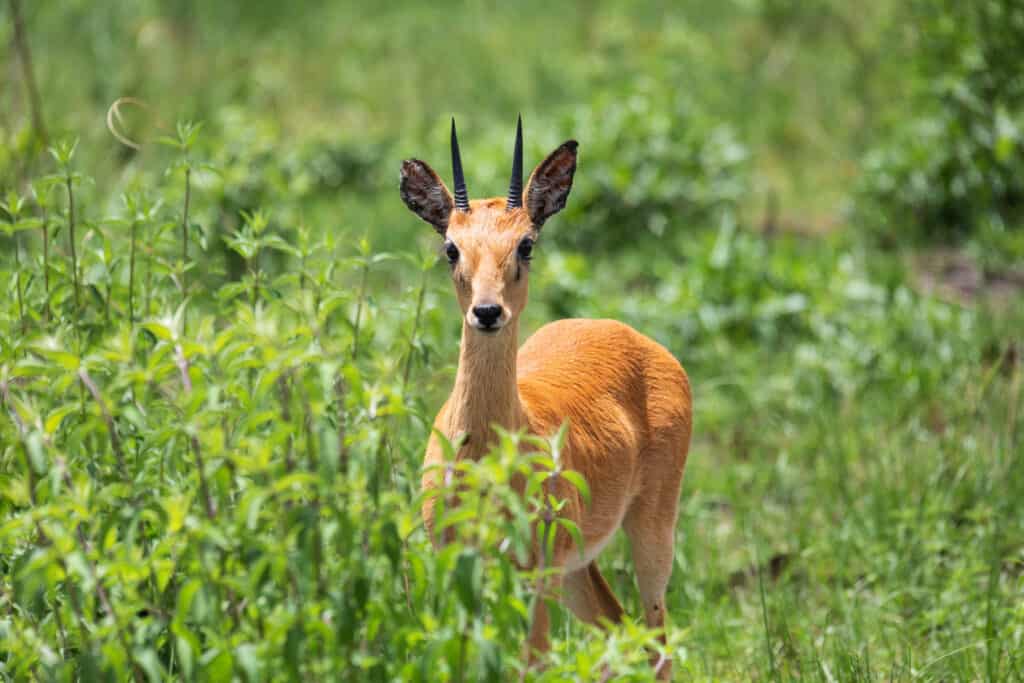
The dik-dik belongs to the dwarf antelope family, which also includes the oribi.
©Artush/Shutterstock.com
4 Types of Dik-Dik
There are four species of dik-diks and several subspecies, with the exact number and designations under discussion by scientists.
- Günther’s dik-dik (Madoqua guntheri): Also referred to as Guenther’s dik-dik, this species is typically found in Ethiopia’s lowlands, the north and east of Kenya, Somalia, Sudan’s southeastern regions, and Uganda but do not live in coastal areas. One distinguishing feature is their elongated snouts, which are able to turn in all directions. Scientists have proposed that four subspecies based on differences in size and hair exist, but these remain unconfirmed as they have not been analyzed genetically.
- Kirk’s dik-dik (Madoqua kirkii): These dik-diks are mainly found in eastern and southwestern Africa. It’s believed to have several subspecies, with one additional potentially in southwest Africa. The Kirk’s dik-dik has a shorter snout that creates a more wedged-shaped head than Günther’s dik-dik.
- Salt’s dik-dik (Madoqua saltiana): Taking its name from Henry Salt, who was the first European to recognize the species in the 9th century in Abyssinia, this dik-dik is present in the Horn of Arfica’s semidesert, bushland, and thicket habitats. It can be found in Kenya’s north and Sudan’s east as well. Their coloring differs greatly depending on the subspecies. Along with the closely related silver dik-dik, this species forms the subgenus Madoqua (Günther’s and Kirk’s dik-diks are in the subgenus Rhynchotragus). The taxonomy is under dispute, but currently there are thought to be five subspecies of Salt’s dik-dik.
- Silver dik-dik (Madoqua piacentinii): The smallest of the dik-diks, this species reaches only 30-33 cm (12-13 inches) in height and weighs a scant 2-3 kg (4.5-6.6 pounds). Its name is reflected in the grizzled silvery color of its back and flanks. It makes its home in the thickets of Somalia’s southeastern coast and southeastern Ethiopia’s Shebelle Valley.
The Kirk’s dik-dik is thought to have four subspecies (though these may represent three or more distinct species):
- M. k. kirkii
- M. k. cavendishi, called Cavendish’s dik-dik
- M. k. damarensis, known as Damara dik-dik
- M. k. hindei.
The Salt’s dik-dik subspecies are disputed, but there are generally considered five subspecies that live in separate habits and differ in coloring:
- M. s. saltiana
- M. s. hararensis
- M. s. lawrenci
- M. s. phillipsi
- M. s. swaynei.
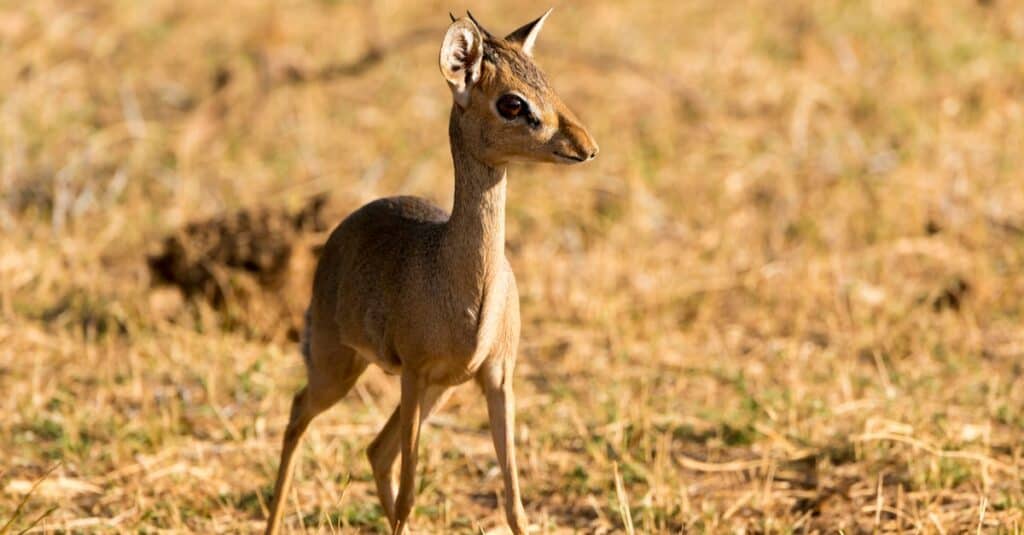
Günther’s dik-dik is one of four dik-dik species.
©imageBROKER.com/Shutterstock.com
Evolution and History
Dik-diks are believed to have a long lineage that traces back around 12 million years ago to the Miocene Epoch.
It’s thought that their small stature is a secondary adaptation due to their gestation time being more like that of animals with larger hoofs and therefore larger bodies. An adaptation resulting from living in habitats in Africa with extremely hot temperatures is that the dik-dik will pant, pushing blood through its snout and using the airflow and evaporation to cool the blood before it’s circulated back through the animal’s body.
It’s been theorized that dik-diks evolved to be primarily monogamous as a defensive response to predators. If there are many predators in its habitat, being in a pair offers protection, and seeking a new partner may be more dangerous if the animal needs to enter new territory, exposing itself to the risk of predation.
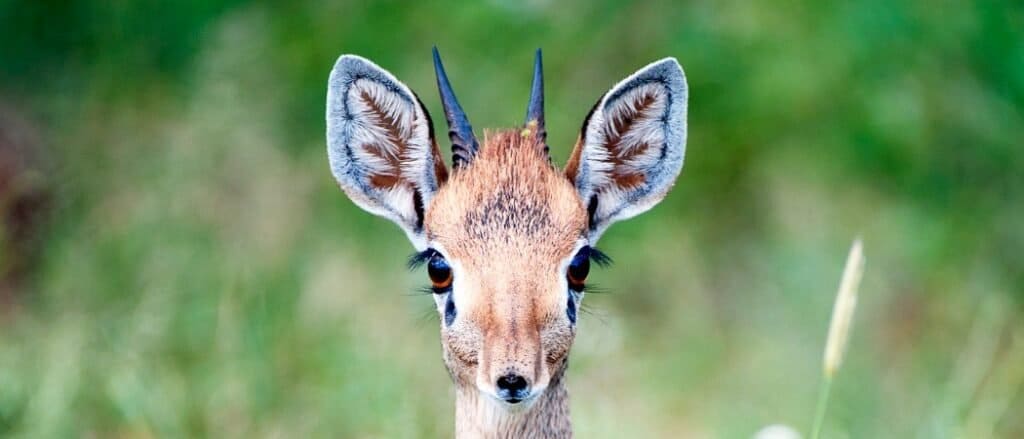
The dik-dik’s small size may be a secondary adaptation, indicated by their gestation time being similar to larger animals.
©iStock.com/pilesasmiles
Appearance and Behavior
The upper body of this small antelope is covered in brownish-gray hair, and it has tan hair on its underbelly. The species known as a silver dik-dik is an exception with gray or silver-colored hair on its upper body. This animal has small areas of black at the corner of each eye. The dark color is from a liquid that is released from glands located there. Males have short, ridged 3-inch-long horns that bend in a backward direction. These animals have two pointed ears, four hooves, a long nose, and huge brown eyes. They rely on their nose for more than a sense of smell. They can use their long nose to pick up things and grab vegetation as they eat.
They can be from 12 to 16 inches tall and have a weight ranging from 7-15 pounds. A line of 7 and a half golf tees end to end on the ground would equal the height of a 16-inch dik-dik. One weighing 15 pounds would be equal in weight to a bowling ball. Now you see why they are called very small antelopes! The Kirk’s is the largest species and can be as tall as 18 inches at the shoulder.
A Suni is another small antelope living in Africa. Sunis and dik-diks are a lot alike in size, weight, and height. One difference is Sunis are more social than dik-diks.
Because of its small size, this animal is vulnerable to many predators. Their only defense is their speed. They can run up to 26 mph. Also, they run in a zig-zagging pattern to try to escape. If a predator is not able to mimic this zig-zagging pattern, it can give this small antelope the seconds it needs to get away.
They make a noise with their nose when they spot a predator in the area. This noise sounds like the words dik-dik. This is how they warn others of danger in the area. Dik-diks are shy and like to remain hidden in the shrubs and brush.
These small antelopes live in monogamous pairs. This is rare because antelopes usually live in large groups or herds. A herd of sable antelopes can contain as many as 70 members! Living in a large herd can provide these bigger antelopes with protection from predators.
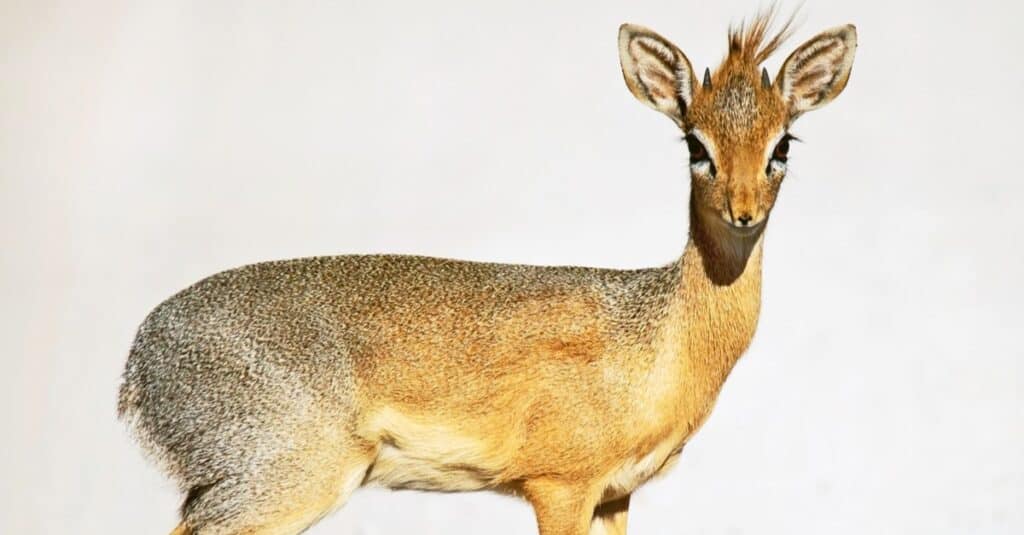
Dik-diks can measure 12-16 inches in height and weigh 7-15 pounds.
©Dirk Theron/Shutterstock.com
Habitat
These small antelopes live in the eastern and southern parts of Africa. They live in a warm climate on savannahs, shrublands, and some wooded areas. They avoid areas with tall grass due to their small size. You can imagine how easily they could become lost in a field of tall grass! These creatures look for places with lots of vegetation around them, so they always have a food source. Their dark hair helps them to blend in with their dry environment.
Though these animals may choose a territory near a stream or creek, they don’t require a water source in their habitat. They get most of the water they need from the vegetation and berries in their diet.
A monogamous pair of dik-diks go to a lot of trouble to establish their territory. Both members of the pair urinate and spread their feces in areas to mark the boundaries of their territory. In addition, they put their scent onto their territory by rubbing their faces in the grass or shaking their heads. This leaves behind a dark, tar-like liquid leaking from the glands located at the corners of their eyes. This gland is called the preorbital gland.
Sometimes male dik-diks ignore all of these scent marks and wander into the territories belonging to other male and female pairs. When this happens, the males go through a routine of charging at one another. During this encounter, they may bump their heads together or push each other. This can go on for several minutes. Eventually, one male moves away and lets the other have the territory. Normally, neither animal is injured after this confrontation. But there’s a very good chance that the intruder won’t come back.

Dik-diks live in savannahs, shrublands, and some wooded areas.
©iStock.com/FARUK BUDAK
Predators and Threats
This small animal has quite a few predators to contend with. Hyenas, eagles, monitor lizards, and leopards are some of their predators. These animals are all larger than dik-diks, so they are easily overpowered. Furthermore, some of these animals are as fast or faster than this small antelope.
Humans have also been known to hunt or trap dik-diks. Traps are set in the scrubland for these animals to step into. They are poached so their skin and coat can be used to make gloves. These gloves are sold for a high price. In addition, traditional jewelry can incorporate small bones from the dik-dik’s legs and feet. Hunters may also kill these animals because their sounds alert other animals and make them run away.
Three species of dik-dik including the Kirk’s, Günther’s, and Salt’s are categorized as Least Concern with a stable population by the IUCN Red List of Threatened Species. The Silver species is listed as Data Deficient, and biologists believe their population is decreasing.
There are areas of land in Africa that offer protection to these animals, so they won’t fall prey to hunters. These protections have contributed to keeping their population stable.
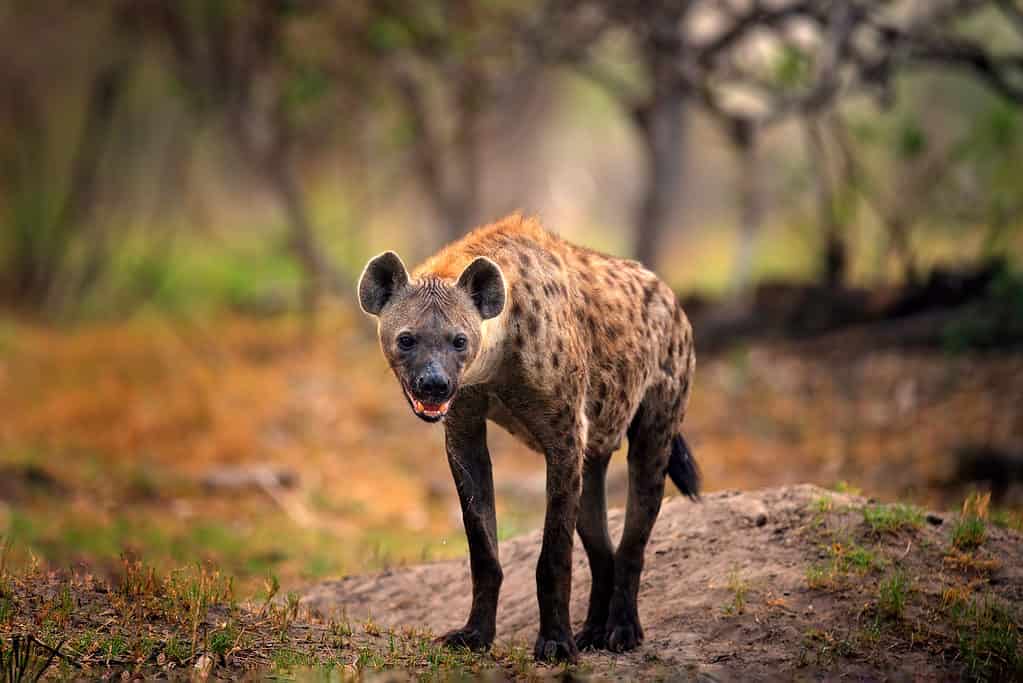
Hyenas are one of the dik-dik’s predators.
©Ondrej Prosicky/Shutterstock.com
Diet
Dik-diks are herbivores and eat a diet of roots, plants, grass, and berries. They look for food in the evening and night so they can hide in the darkness while away from their shelter. Plus, it’s cooler in the evening and at night.
They soak in a lot of water by eating vegetation, so they don’t have to drink water from creeks or streams very often. This is beneficial to them because they are particularly vulnerable to predators while visiting a body of water to drink.
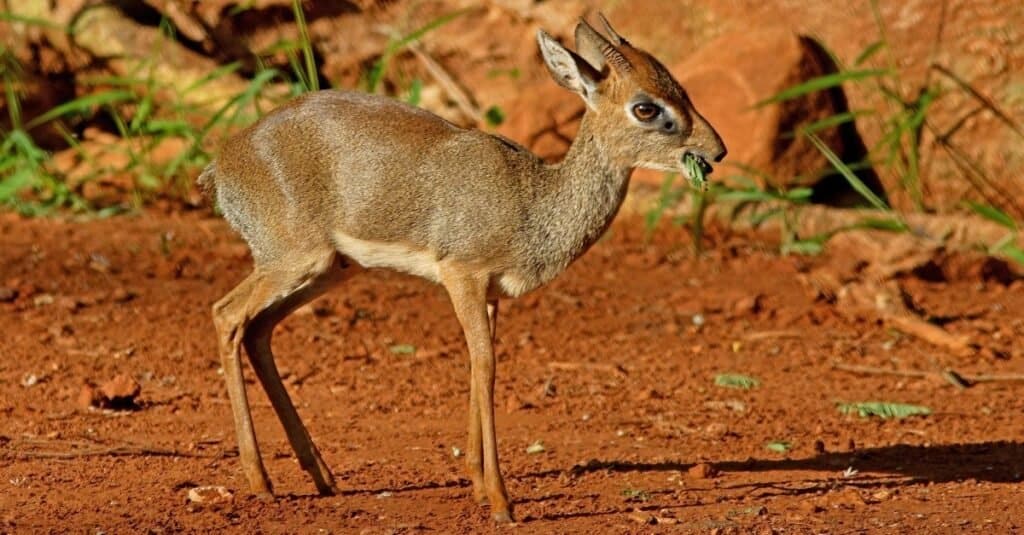
Dik-diks are herbivores and eat plants, grass, roots, and berries.
©iStock.com/neil bowman
Babies, Reproduction, and Lifecycle
These animals live in pairs of males and females on a section of territory. They are primarily monogamous; it’s been observed that males may initiate extra-pair mating if a rare, suitable opportunity is presented. In terms of sexual maturity, males reach maturity at 12 months and females at 6 months. The female can have two babies per year, but only has one at a time.
Generally, females give birth in November and December and then in April and May. She gives live birth to a baby or calf, weighing from 1 to 1.6 pounds. This animal pays a big price for being so small at birth. In fact, a newborn’s survival rate is 50%. So, it’s not surprising to learn that this creature stands up just 5 minutes after birth! It must do all it can to stay safe from nearby predators.
As a comparison, another small creature called the Royal antelope is monogamous and has a single newborn calf that weighs a little bit more at 1.8 to 2.2 pounds.
The mother dik-dik nurses her calf for about 6 weeks before it starts the weaning process. They are fully weaned at around 3 to 4 months of age. At 7 months of age, the male and female dik-diks chase the calf out of their territory so it can live independently and find a mate.
The lifespan of a wild dik-dik is 5 to 10 years. In captivity, its lifespan can reach 15 years. They live longer in captivity because they don’t have to deal with predators.

A dik-dik can live 5-10 years in the wild.
©iStock.com/pilesasmiles
Population
Salt’s, Günther’s, and Kirk’s dik-diks are all listed as Least Concern with a stable population. The silver dik-dik is Data Deficient.
- Salt’s dik-dik’s population is 485,600 individuals in the eastern part of Africa (Somalia and Ethiopia).
- Günther’s dik-dik population is 511,000 individuals in eastern Africa including Kenya, Somalia, and Ethiopia.
- Kirk’s dik-dik has a population of 971,000 individuals in the eastern part of Africa (Kenya, Tanzania) and in the west (Namibia).
Dik-Dik FAQs (Frequently Asked Questions)
What is a dik-dik?
This animal is a very small antelope with brownish gray hair, a short nose, and large dark eyes. It lives in various areas on the continent of Africa. Its habitat includes shrublands and savannahs. Their diet consists of berries, grass, roots, and other vegetation.
These animals pay a price for being so small compared to others in their habitat. In short, they have many predators and are always on the lookout for danger. But they can run at speeds of up to 26 mph and are able to warn other dik-diks with a whistling sound they make through their nose. The noise this animal makes sounds a lot like its own name.
Are dik-diks carnivores, herbivores or omnivores?
They’re herbivores.
How do you pronounce dik-dik?
Pronounce this animal’s name like you are saying the words dick-dick. So, you pronounce this word with a short sounding letter i.
Can you keep a dik-dik as a pet?
No, dik-diks are not house pets. Though their small size may make them seem like good pets, they can cause damage and hurt themselves inside a home. They are wild animals that need to be out on the savannah or in the shrublands where they have plenty of space to run and be free!
Why is a dik-dik called a dik-dik?
This animal earned its name due to a sound it makes. If one of these small antelopes sees or picks up the scent of a predator in the area it alerts other dik-diks with a whistling sound made through its nose. The noise sounds like the words “dik-dik.” Alerting other animals of a predator gives this small creature some time to hide or get away.
Is the dik-dik endangered?
No, they are not endangered. They are Least Concern with a stable population.
Thank you for reading! Have some feedback for us? Contact the AZ Animals editorial team.
Sources
- African Wildlife Foundation, Available here: https://www.awf.org/wildlife-conservation/dik-dik
- Edinburgh Zoo, Available here: https://www.edinburghzoo.org.uk/animals-and-attractions/animals/kirks-dik-dik/
- Mary Bates Science Writer, Available here: https://marybatessciencewriter.com/home/2015/08/03/the-creature-feature-10-fun-facts-about-the-dik-dik
- Mpala Live!, Available here: https://www.mpalalive.org/field_guide/guenthers_dik_dik

















